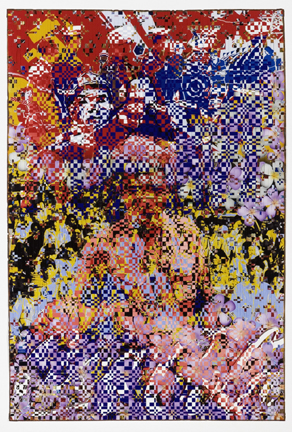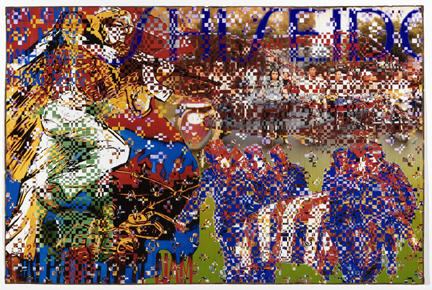Dinh Q. Le at Elizabeth Leach Gallery

Dinh Q. Le Untitled (Crowd), 2007 Photo Courtesy Elizabeth Leach Gallery
When you walk into the Elizabeth Leach gallery this month, a barrage of imagery simultaneously assaults and seduces. The colors of Dinh Q. Le's six works in the outer gallery grab your eye again and again, in an overload of pulsing industry. They are pharmaceutical colors, candied colors. They are the colors of advertising, the colors of film and HDTV, of governments in graphics and comic book superheros, of neon and stylized nostalgia. These colors are meant to sink in and hold, to visually delight, to leave you wanting in a sea of abundance. The psychedelia is a bit overwhelming, yet the longer one pauses to look, the more rich these works become, revealing themselves to be infinitely more intricate than thought possible at first glance.
Dinh Q. Le creates these woven photos as embodiments of an abstract place. They pulse in the gallery space, existing for the placeless among us: those who have experienced the deep chasm and subsequent marriage of life between and within disparate times, cultures, governments and philosophies. It is a strange space, one that seems to have sudden small existential crisises and alternate, ecstatic moments of triumph. These works seem to draw from Op Art, Pop Art, and the dragon history of painting.

Bridget Riley "Movement in Squares" 1961
Candy, communism and the flowers of mourning punctuate the miasma of Dinh Q. Le's language as he attempts to create the visual mythology of his experience.. The interim that is the now experience seems to result from Le's weaving, his fingers creating the web of time that wraps around us. Of course, the well from which Le gleans his imagery is extremely specific, and as the viewer sits and watches, the familiar logos of enormous corporate super giants advance and recede amidst throngs of Vietnamese citizens and soldiers, stylized figurines, bits of candy, and silenced ideals of femininity, spirituality, and strength. As these images speak to of us of confusion and an identity lost and consumed, trampled upon by the overbearing scream and push of consumerist propaganda, they also speak of the act of remembering and the passage of time. How does time alter our memories? Do they change shapes and colors? Are they sculpted by the intense and overpowering visual forces of our image saturated culture, or are they the sole result of our individual experience?

Dinh Q. Le, Untitled (Shiseido), 2007, Photo Courtesy Elizabeth Leach Gallery
Le's video installation, "From Father to Son: A Rite of Passage", is a powerful display of marked and comparable proprietors of memory as he juxtaposes the actor Martin Sheen next to his son Charlie Sheen in their respective roles as soldiers in both "Apocalypse Now" and "Platoon". Despite the synopsis on the gallery wall, this piece is not portrayed as a chronologically linear depiction. The frames of each film occur coincidentally. The result is the experience of witnessing an entire generation of men battle the same war. Formally, this piece is poignantly and powerfully evocative. Both Sheens bare a startling resemblance to one another, and each man's respective character bares the existential burden of being a young man ordered and expected to execute atrocities under the mandate of war. The irony is that their war is the same losing battle. The political implications of such a piece and the ideas behind it at this time in America are raw and festering. Le subtly hints at the possibility of the present situation in Iraq mirroring those of Vietnam and warns us of the endless cycle of suffering resulting from a lack of learning from our histories. This work reifies the experience of a global culture and revives the practice of visual storytelling; it is the event of time compressed, woven, and juxtaposed.




















